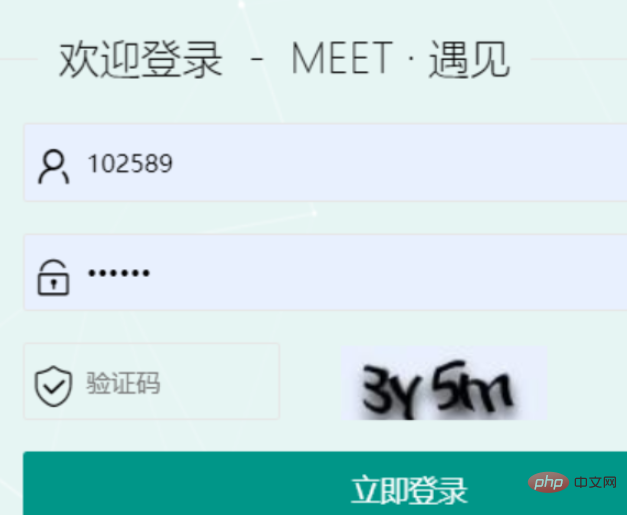
When we log in and use the verification code in the project, we might as well try Kaptcha to generate the verification code. It is very simple.
1. First, we introduce kaptcha in the pom.xml file maven dependency
<!-- kaptcha验证码 --> <dependency> <groupId>com.github.penggle</groupId> <artifactId>kaptcha</artifactId> <version>2.3.2</version> </dependency>
2. Then, we write kaptcha’s configuration class: KaptchaConfig.java
package com.lzzy.meet.common.kaptcha;
import com.google.code.kaptcha.impl.DefaultKaptcha;
import com.google.code.kaptcha.util.Config;
import lombok.extern.slf4j.Slf4j;
import org.springframework.context.annotation.Bean;
import org.springframework.stereotype.Component;
import java.util.Properties;
/**
* @ClassName KaptchaConfig
* kaptcha配置类
* @Author
* @Date 2019-09-05 13:50:50
* @Version 1.0
**/
@Slf4j
@Component
public class KaptchaConfig {
@Bean
public DefaultKaptcha getKaptcheCode() {
DefaultKaptcha defaultKaptcha = new DefaultKaptcha();
Properties properties = new Properties();
properties.setProperty("kaptcha.border", "no");
properties.setProperty("kaptcha.textproducer.font.color", "black");
properties.setProperty("kaptcha.image.width", "100");
properties.setProperty("kaptcha.image.height", "36");
properties.setProperty("kaptcha.textproducer.font.size", "30");
properties.setProperty("kaptcha.obscurificator.impl", "com.google.code.kaptcha.impl.ShadowGimpy");
properties.setProperty("kaptcha.session.key", "code");
properties.setProperty("kaptcha.noise.impl", "com.google.code.kaptcha.impl.NoNoise");
properties.setProperty("kaptcha.background.clear.from", "232,240,254");
properties.setProperty("kaptcha.background.clear.to", "232,240,254");
properties.setProperty("kaptcha.textproducer.char.length", "4");
properties.setProperty("kaptcha.textproducer.font.names", "彩云,宋体,楷体,微软雅黑");
Config config = new Config(properties);
defaultKaptcha.setConfig(config);
return defaultKaptcha;
}
}3. Next, we write kaptcha’s control layer: KaptchaController.java
package com.lzzy.meet.common.kaptcha;
import com.google.code.kaptcha.Constants;
import com.google.code.kaptcha.Producer;
import lombok.extern.slf4j.Slf4j;
import org.springframework.beans.factory.annotation.Autowired;
import org.springframework.stereotype.Controller;
import org.springframework.web.bind.annotation.GetMapping;
import org.springframework.web.bind.annotation.RequestMapping;
import javax.imageio.ImageIO;
import javax.servlet.ServletOutputStream;
import javax.servlet.http.HttpServletRequest;
import javax.servlet.http.HttpServletResponse;
import java.awt.image.BufferedImage;
/**
* @ClassName KaptchaController
* kaptcha调用
* @Author
* @Date 2019-09-05 13:59:59
* @Version 1.0
**/
@Slf4j
@Controller
@RequestMapping("kaptcha")
public class KaptchaController {
@Autowired
private Producer producer;
@GetMapping("kaptcha-image")
public void getKaptchaImage(HttpServletRequest request, HttpServletResponse response) throws Exception {
response.setDateHeader("Expires", 0);
response.setHeader("Cache-Control", "no-store, no-cache, must-revalidate");
response.addHeader("Cache-Control", "post-check=0, pre-check=0");
response.setHeader("Pragma", "no-cache");
response.setContentType("image/jpeg");
String capText = producer.createText();
log.info("******************当前验证码为:{}******************", capText);
// 将验证码存于session中
request.getSession().setAttribute(Constants.KAPTCHA_SESSION_KEY, capText);
BufferedImage bi = producer.createImage(capText);
ServletOutputStream out = response.getOutputStream();
// 向页面输出验证码
ImageIO.write(bi, "jpg", out);
try {
// 清空缓存区
out.flush();
} finally {
// 关闭输出流
out.close();
}
}
}4. Then, we can call the katpcha interface on the front end to generate the verification code:
<img class="ver_btn lazy" src="/static/imghw/default1.png" data-src="@{/kaptcha/kaptcha-image}" th: onclick="this.src=this.src+'?c='+Math.random();"/ alt="How SpringBoot uses Kaptcha to implement verification code generation and verification functions" >Since I am using the thymeleaf template engine here, the path name will be a bit strange, and the generated verification code style As shown in the figure:

5. Finally, we send the verification code entered by the user when logging in on the client to the server for verification:
/**
* 验证验证码
* @param
* @return 正确:true/错误:false
*/
public static boolean validate(String registerCode) {
// 获取Session中验证码
Object captcha = ServletUtils.getAttribute(Constants.KAPTCHA_SESSION_KEY);
// 判断验证码是否为空
if (StringUtils.isEmpty(registerCode)) {
return false;
}
// 校验验证码的正确与否
boolean result = registerCode.equalsIgnoreCase(captcha.toString());
if (result) {
// 正确了后,将验证码从session中删掉
ServletUtils.getRequest().getSession().removeAttribute(Constants.KAPTCHA_SESSION_KEY);
}
// 返回验证结果
return result;
}The above is the detailed content of How SpringBoot uses Kaptcha to implement verification code generation and verification functions. For more information, please follow other related articles on the PHP Chinese website!
 SpringBoot project building steps
SpringBoot project building steps
 What is the difference between j2ee and springboot
What is the difference between j2ee and springboot
 How to get http status code in PHP
How to get http status code in PHP
 Introduction to linux system classification
Introduction to linux system classification
 How to solve the problem that Ethernet cannot connect to the internet
How to solve the problem that Ethernet cannot connect to the internet
 What to do if postscript cannot be parsed
What to do if postscript cannot be parsed
 How to view Tomcat source code
How to view Tomcat source code
 How to buy Bitcoin
How to buy Bitcoin
 What does vram mean?
What does vram mean?




